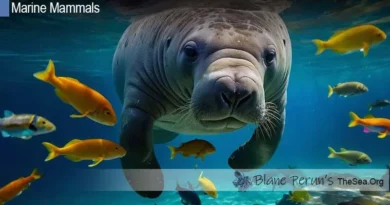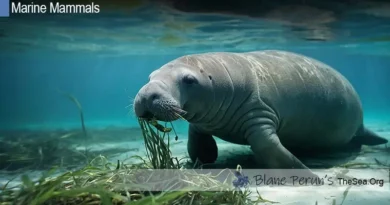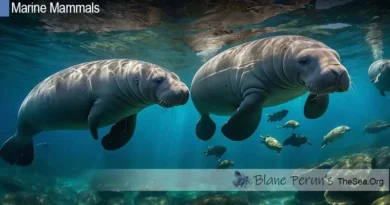Manatee Predators
Table of Contents
Manatee Predators: Navigating the Waters of Threats and Survival
Manatees, often referred to as gentle giants of the sea, navigate a world filled with a surprising array of challenges. These marine mammals, belonging to the order Sirenia and scientifically known as Trichechus, have a serene existence that belies the dangers lurking in their aquatic habitats. Despite their large size and lack of natural enemies in the traditional sense, manatees face a range of threats that can be considered predatory in their impacts. This exploration delves into the less-discussed aspect of manatee life – their predators and the dangers they face in the wild.
Natural Predators and Threats
The Role of Sharks in Manatee Predation
While manatees don’t have a long list of natural predators, sharks, particularly bull sharks (Carcharhinus leucas), have been known to pose a threat. These encounters are rare but can be fatal due to the shark’s predatory capabilities. Bull sharks, known for their aggressive nature and ability to thrive in both salt and freshwater, can inadvertently come into contact with manatees in estuaries and shallow coastal areas where manatees feed and breed. The interactions between these two species are not well-documented, but the sheer size and power of bull sharks make them a formidable threat to the slow-moving manatees.
Crocodiles and Alligators: An Overlooked Danger
Another potential natural threat comes from large reptiles like the American crocodile (Crocodylus acutus) and the American alligator (Alligator mississippiensis). These apex predators inhabit some of the same warm, shallow waters as manatees, particularly in the Florida Everglades. While attacks are exceptionally rare, the sheer size and predatory nature of these reptiles can pose a risk to young or sickly manatees. It’s a stark reminder that even in the serene waters where manatees dwell, the law of nature and the presence of predators like crocodiles and alligators add an element of unpredictability to their existence.
Human-Induced Threats
The Impact of Watercraft
Boats and personal watercraft pose one of the most significant threats to manatees. Collisions with watercraft can result in serious injuries or fatalities for these marine mammals. The propellers and hulls of boats can cause deep lacerations, broken bones, and even death. Manatees, with their slow-moving nature and frequent surface visits for air, are particularly vulnerable in busy waterways. Efforts to mitigate these incidents include the implementation of manatee zones with strict speed limits, yet the threat remains a significant concern for the conservation of these gentle giants.
Environmental Degradation and Its Effects
Pollution, habitat destruction, and climate change are indirect predators of manatees, impacting their survival in profound ways. Pollution can lead to algal blooms that reduce the oxygen levels in the water and kill the seagrass that manatees feed on. Habitat destruction, whether through coastal development or deforestation, reduces the natural feeding and breeding grounds of manatees, pushing them closer to areas of human activity where they are more vulnerable. Climate change also affects the temperature and salinity of the waters manatees inhabit, which can have long-term effects on their migration patterns and reproductive rates.
Unnatural Predators: Entanglement and Pollution
The Peril of Fishing Gear
Fishing gear, including lines, nets, and hooks, can become deadly obstacles for manatees. These creatures, curious by nature, can become entangled in fishing gear, leading to injuries, infections, or even drowning if they’re unable to surface for air. The removal of such entanglements often requires human intervention, and while many manatees are rescued and rehabilitated, the process can be stressful and potentially harmful to the individual.
Pollution’s Invisible Threat
Chemical pollutants and marine debris pose a less visible but equally dangerous threat to manatees. Ingesting or becoming entangled in marine debris can lead to severe health issues or impede a manatee’s ability to swim and surface for air. Chemical pollutants, on the other hand, can contaminate the water and the seagrass beds that manatees depend on, leading to a decline in food quality and availability. These pollutants can also have long-term effects on manatee health, impacting their immune and reproductive systems.
In conclusion, while manatees may not face the traditional predator-prey dynamics seen in other wildlife species, they are not free from threats. From the rare but possible attacks by sharks and crocodiles to the more pervasive dangers posed by human activities, manatees navigate a complex landscape of risks. Understanding these threats is crucial for the conservation efforts aimed at ensuring the survival of these majestic marine mammals.
FAQs on Manatee Predators
1. Do manatees have any natural predators? While manatees have very few natural predators due to their large size, they can occasionally fall prey to sharks, specifically bull sharks, and, in rare cases, to large crocodiles or alligators. However, these incidents are not common.
2. How do boats and watercraft pose a threat to manatees? Boats and watercraft are significant threats to manatees due to collisions. The manatees’ slow-moving nature and need to surface for air make them vulnerable to boat propellers and hulls, which can cause severe injuries or even death.
3. Can pollution affect manatees? Yes, pollution can significantly affect manatees. Chemical pollutants can contaminate their aquatic environment and food sources, leading to health issues. Marine debris can also entangle manatees or be ingested, causing internal injuries or impeding their ability to swim and breathe.
4. What impact does climate change have on manatees? Climate change can alter the temperature and salinity of the waters where manatees live, affecting their migration patterns and the availability of their primary food source, seagrass. It can also lead to more frequent and severe algal blooms, which reduce water quality and food availability.
5. Are there any efforts to protect manatees from these threats? Conservation efforts to protect manatees include the establishment of protected areas, speed-regulated zones to prevent boat collisions, rescue and rehabilitation programs for injured manatees, and policies aimed at reducing pollution and mitigating the effects of climate change on marine ecosystems.




